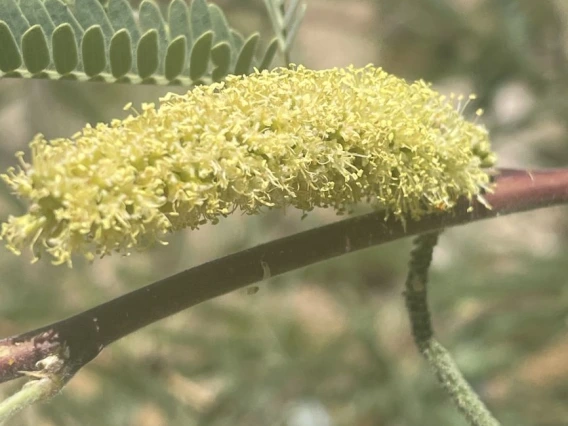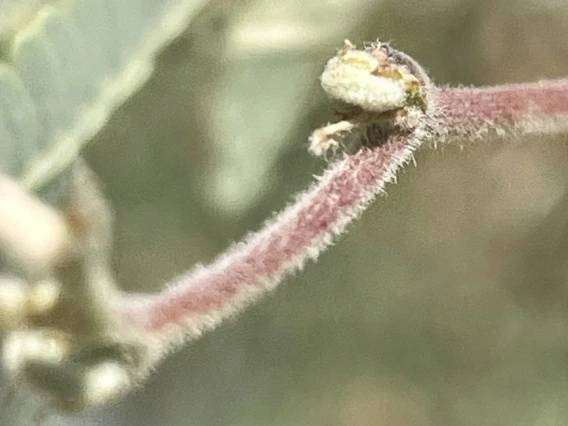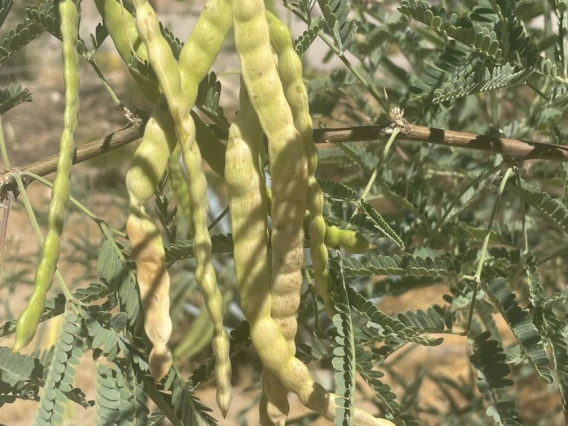


Common Names:
- English: Velvet Mesquite
- Spanish: Mezquite
- O’odham: Kui
Family: Fabaceae (pea/legume family) | Synonym: Leguminosae
Botanical Name: Prosopis velutina
Rain Garden Zone: P. velutina thrives in the terrace rain garden zone, but may grow well in the bottom rain garden zone as well provided that the base of the trunk is not at the lowest point of the grade where it will be subjected to prolonged periods in standing water. The terrace zone is typically atop a terrace or on the bank of a basin or swale. These sites have more shallow, less-frequent, and more temporary pooling than in bottom zone.

Reproduced with permission from "Rainwater Harvesting for Drylands and Beyond" by Brad Lancaster, HarvestingRainwater.com
Flowering Season: April – June, August - September
Harvest Season (Pods):
- Low Desert: May – June, October – November
- High Desert: June – August, November – January
Harvest Techniques: Harvest mesquite pods before the summer rains. Pods should be picked from the tree rather from the ground, and pods from particular trees should be taste-tested first for desired characteristics. Each tree has its own unique flavor, so harvest only from trees whose taste is desirable. Pods are ready to harvest when they easily snap into two when bent. In the low desert, harvest ripe pods before summer rains to avoid aflatoxins.
Planting Season: Monsoon
Landscape Cultivation: Nick the seed coat or use sandpaper to thin the hard seed coat so as to allow water into the seed for germination. Plant mesquite in the terrace or bottom rain garden zones. Avoid placing trees where the trunks will experience prolonged (>12 hours) standing water.
Characteristics: P. velutina is considered a large shrub or small tree that grows to a height of 30’ or more depending on irrigation. It has distinctive rough, dark brown bark. The flowers are small, greenish-yellow cylindrical spikes, upon which the seed pods grow. Seed pods are a brown color when mature and reach 8’’ long. The leaves of the P. velutina are light green and bi-pinnately compound.
Ecological Benefits: Velvet mesquite is home to over 60 native bee species and is an important species for many other pollinators. Wildlife take advantage of this mesquite’s pods, and forests of mesquite that grow along desert rivers, provide habitats for birds and mammals. Velvet mesquite trees are homes to nesting birds and an oasis for pollinators. Both large and small mammals eat mesquite pods. For example, the diet of coyotes consist of 80% mesquite during the late summer months.
Practical Uses:
- Food - Velvet mesquite, as well as other varieties of mesquite, is highly valuable as a food source due to the abundance and reliability of pods produced, and the high nutritional content. Almost all species of Prosopis and other members of the legume family, produce pods that have been a key food source for indigenous people for thousands of years. Members of the bean family, are able to fix nitrogen from the soil, providing a source of nitrogen that is incorporated into proteins in the fruit. Beans from velvet mesquite trees have a protein content of 29-39.9% and are a source of calcium, magnesium, dietary fiber, iron, and zinc. Mesquite beans are ready to harvest during the summer monsoon season, and into the autumn and winter in some regions. After harvest, mesquite pods are dried and ground into a powder that is used much like white wheat flour, to be moistened with water and formed into cakes. Additionally, mesquite pods can be cooked down into a broth or a syrup to release a sweet flavor which can be used in food and drink.
- Domestic Animal Uses - Ground mesquite pods can be used as chicken, goat, and cattle feed. Pods can be ground and made into dog biscuits. Honey bees feed on the nectar of mesquite, pollinate, and produce honey with a distinct flavor. .
- Other Uses - Velvet mesquite is valued for its domestic uses beyond food—mesquite has traditionally been used for fiber weaving/basketmaking, medicine, wood/timber, pigments, and shelter. Sap from sweet-tasting trees can be made into soothing cough drops. Fallen leaves from a mesquite tree can be an excellent source of nitrogen-fixation for a vegetable garden in both the winter and summer months. All species of mesquite are great shading trees and can be used for gardens, compost, and urban planning.
References:
- Desert Harvesters. (2018). Eat mesquite and more: a cookbook for Sonoran desert foods and living. Tucson, AZ. RainSource Press.
- Hodgson, W. C. (2001). Food plants of the Sonoran desert. Tucson, AZ. University of Arizona Press.
- Lancaster, B. (2019) Rainwater harvesting for drylands and beyond, 3rd edition. Tucson, AZ. RainSource Press.
- Little, E. L. (1980). The Audubon Society field guide to North American trees, western region. Alfred A. Knopf.
For more information on this plant, see the Campus Arboretum species description pages.
Go to the next tour stop: ironwood page or Return to the main Dunbar Spring tour page

